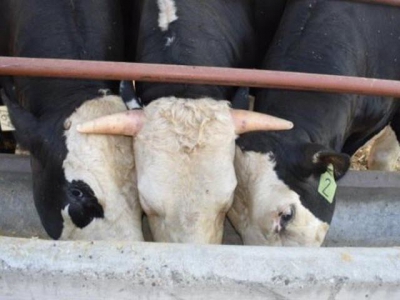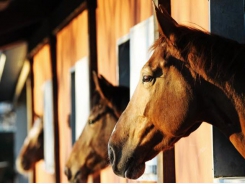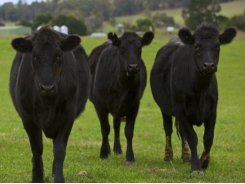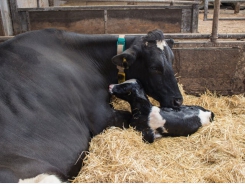Genome-edited bull passes hornless trait to calves

Study sheds light on need to screen donor plasmids, while new methods no longer use donor template plasmids to insert desired gene into genome
A horned bull from a control group is flanked by two hornless offspring of a genome-edited bull.
For the past two years, researchers at the University of California-Davis (UC-Davis) have been studying six offspring of a dairy bull that had been genome edited to prevent it from growing horns. This technology has been proposed as an alternative to dehorning -- a common management practice performed to protect other cattle and human handlers from injuries, UC-Davis said in an announcement.
UC-Davis scientists have published their findings in the journal Nature Biotechnology. In the journal article, they reported that none of the bull's offspring developed horns, as expected, and bloodwork and physical exams of the calves found that they were all healthy. The researchers also sequenced the genomes of the calves and their parents and analyzed these genomic sequences, looking for any unexpected changes.
UC-Davis noted that all data were shared with the U.S. Food & Drug Administration, and an analysis by FDA scientists revealed that a fragment of bacterial DNA used to deliver the hornless trait to the bull had integrated alongside one of the two hornless genetic variants, or alleles, that were generated by genome editing in the bull. UC-Davis researchers have further validated this finding, the university said.
"Our study found that two calves inherited the naturally occurring hornless allele, and four calves additionally inherited a fragment of bacterial DNA known as a plasmid," said corresponding author Alison Van Eenennaam with the UC-Davis department of animal science.
Plasmid integration can be addressed by screening and selection -- in this case, selecting the two offspring of the genome-edited hornless bull that inherited only the naturally occurring allele.
"This type of screening is routinely done in plant breeding, where genome editing frequently involves a step that includes a plasmid integration," Van Eenennaam said.
She said the plasmid does not harm the animals, but the integration technically made the genome-edited bull a genetically modified organism because it contained foreign DNA from another species -- a bacterial plasmid, in this case.
"We've demonstrated that healthy hornless calves with only the intended edit can be produced, and we provided data to help inform the process for evaluating genome-edited animals," Van Eenennaam said. "Our data indicate the need to screen for plasmid integration when they're used in the editing process."
Since the original work in 2013, initiated by Minnesota-based company Recombinetics, new methods have been developed that no longer use donor template plasmids or other extraneous DNA sequences to bring about introgression of the hornless allele, the announcement said.
UC-Davis said the researchers did not observe any other unintended genomic alterations in the calves, and all animals remained healthy during the study period. Neither the bull nor the calves entered the food supply, as per FDA guidance for genome-edited livestock.
Many dairy breeds of cattle naturally grow horns, but on dairy farms, the horns are typically removed or the calves "disbudded" at a young age, UC-Davis explained. Animals that don't have horns are less likely to harm animals or dairy workers and have fewer aggressive behaviors. The dehorning process is unpleasant and has implications for animal welfare.
Van Eenennaam said genome editing offers a pain-free genetic alternative to removing horns by introducing a naturally occurring genetic variant, or allele, that is present in some breeds of beef cattle such as Angus.
Other authors on the study include: Amy Young, Tamer Mansour, Bret McNabb and C. Titus Brown with the UC-Davis School of Veterinary Medicine and Joseph Owen and Josephine Trott with the UC-Davis department of animal science. This work was supported by the Biotechnology Risk Assessment Grant Program from the U.S. Department of Agriculture to ALV, the Gordon & Betty Moore Foundation's Data-Driven Discovery Initiative and the California Agricultural Experiment Station of UC-Davis.
Có thể bạn quan tâm
Phần mềm

Phối trộn thức ăn chăn nuôi

Pha dung dịch thủy canh

Định mức cho tôm ăn

Phối trộn phân bón NPK

Xác định tỷ lệ tôm sống

Chuyển đổi đơn vị phân bón

Xác định công suất sục khí

Chuyển đổi đơn vị tôm

Tính diện tích nhà kính

Tính thể tích ao hồ




 Scientists investigate anticoccidial drug efficacy
Scientists investigate anticoccidial drug efficacy  Benefits seen in use of spray-dried plasma in…
Benefits seen in use of spray-dried plasma in…